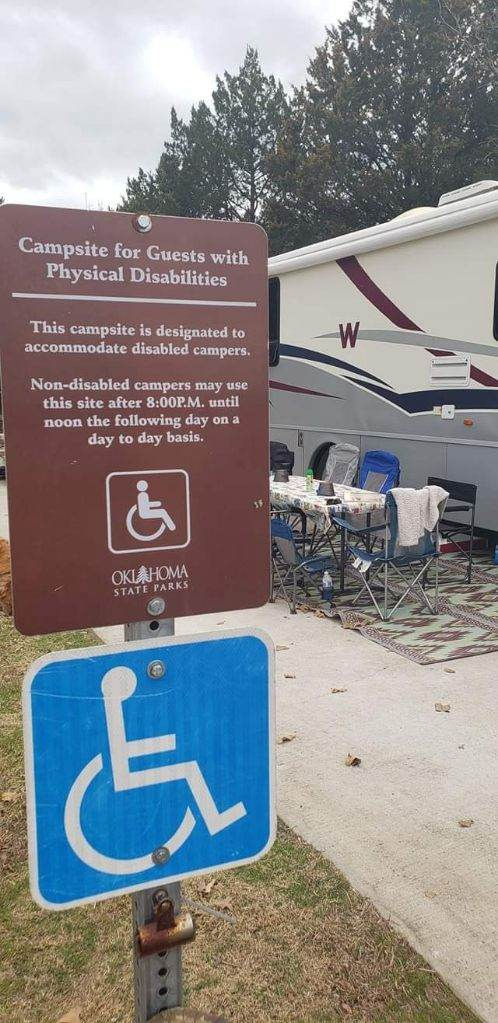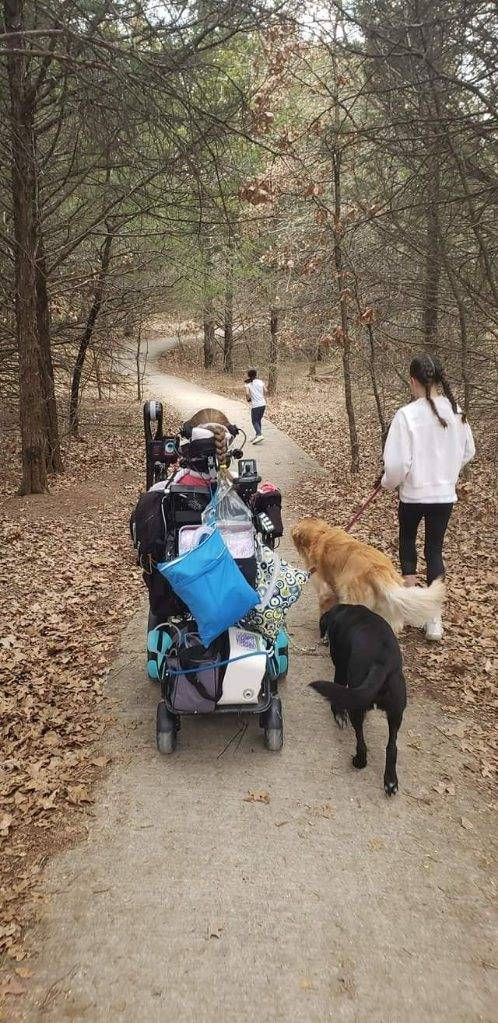What Makes An RV Site Accessible???
- Kate Nelson

- Oct 31, 2022
- 7 min read

This is a question every campground owner/manager should ask themselves!! (I am sure there are a lot who do). Before we started RVing, I never thought about campgrounds having accessible RV/campsites – didn’t occur to me and my daughter uses a wheelchair – this is crazy since I am the mom who thinks every single thing ever should be accessible and every single person on the planet should know how to make things accessible for ALL people…..Ok, anyway, enough of that and a topic for a different day.
When Ryan first toyed with the idea of purchasing an RV, and found Wanda (that's the name of our RV, for those who didn't know - Wanda the Winnebago), I had no idea what to expect, not just with the RV, but also camping! A friend and I were biking through a local state park when I was telling her about Ryan’s RV find and his insane idea to buy it when we came upon the park’s campground (it was a bit of an "oooey-ew"). We decided to ride down to the sites and explore. We came upon a site with a brown handicap sign next to the site number. I think my mouth hung open for a few seconds because I honestly did not know there was such a thing. The site was cement, wide, level, had a fire-ring, had an accessible picnic table AND it was on the lake!! PERFECT! At that moment, my mind was opened up a little bit more to see where my husband’s crazy idea may take our family!
Ok, not ALL RV campgrounds/parks have accessible sites (they totally should), however we have found if there isn’t a designated ADA site, the campground is usually very willing to accommodate us as best they can. With that said, lets explore what makes an RV site and campground accessible.
MUST CAMPGROUNDS COMPLY WITH ADA GUIDELINES?
I’m going to say YES, OF COURSE, ABSOLUTELY!!! But, for a “legal answer” to this question you probably need to consult a lawyer who specializes in ADA regulations. However, Title III of ADA regulations prohibits discrimination on the basis of disability in the activities of places of public accommodations, and campgrounds are places of public accommodations. In 2010, the Department of Justice updated its ADA Standards (https://www.ada.gov/2010ADAstandards_index.htm), which are referred to as the 2010 ADA Standards for Accessible Design. These standards, which replace the original ADA Standards the DOJ issued in 1991, became mandatory for newly constructed and altered facilities as of March 15, 2012. Since then many RV parks/campgrounds and recreation areas have updated their facilities and adding accessible campsites.
In 1968, the Architectural Barriers Act (ABA) issuing standards that apply to facilities designed, built, altered, or leased with federal funds was established. The law applies to federal buildings, including post offices, social security offices, federal courthouses and prisons, and national parks. The standards have been updated several times and the final rule was published in 2004. Since then, National Parks have been striving to make their lands, campsites, buildings, trails, overlooks and recreation areas more accessible for people with disabilities. These changes have enhanced the experience of exploring a National Park for a person with a disability from providing braille and tactile exhibits for the visually impaired, creating more accessible trails, to adding new and more accessible campsites, while keeping the integrity of the natural land intact.
ACCESSIBLE RV SITES – WHAT TO LOOK FOR
Sites that are truly built to standards should offer a level pad, surface stability, proper height accessible tables, fire rings, and hook-ups. We have stayed in some very nice accessible RV sites and then there have been some we thought were accessible that made you scratch your head. We look for sites that are level, has good surface structure, wide enough for the wheelchair lift without going into the grass, and space to wheel around. Oh, and full hook-ups – I like to have full hook-ups!
Here are some things to research before booking:
Campground Website – check the website and use the filters, select ADA or “Accessible Features” to see what is available. State and National Parks usually have this listed in their filters while most private campgrounds may not. If a filter isn't available, don't be discouraged - you can get an idea from looking at the pictures of the sites.
Pictures – most campgrounds will include pictures of their sites. This is very helpful when researching to look at the pad width, is it level, what is the surface made of, does it have a big drop off from the pad to the grass, picnic table, etc. Even if a site isn’t designated as ADA Accessible, you can still get a feel if it will work for your rig and family.
Call the campground – If you don’t see what you’re looking for just give them a call! Some places will only reserve accessible spots by calling them directly. If a campground does not list any accessible sites they will usually accommodate your needs as best they can or be truthful that it may not be a good fit and recommend another place.
All in all, make sure your site is level and the surface is compatible for your mobility needs and don’t forget to look for a great view! It may not be the perfect ADA standards site, but there is a lot that can work.....and, some that won't. We were in Wyoming last summer and the surface was gravel, not packed or crushed granite, but deep gravel – of course, the power wheelchair got stuck, like down IN the gravel! Thank goodness my super strong husband was there to save the day!
OTHER ACCESSIBLE CAMPGROUND FEATURES
When you camp you don’t just want an accessible site, but other features, as well as, to make the entire experience that more pleasurable.
Bathrooms – call the campground and ask if their bathrooms are accessible. Some campgrounds have private ADA accessible bathrooms and showers, which is extremely nice if you won’t be showering in your RV.

Trails – we have been to many state parks, national parks and private campgrounds that have paved, packed or crushed granite trails. Super bonus if you can roll on over and start your hike!
Recreation Areas – bigger campgrounds will offer amenities such as play areas, basketball courts, swimming pools, putt-putt golf, corn hole, etc. and a lot are very accessible!
Camp Store – most camp stores are small, but usually have easy access.
Everyone's needs are different, these are just a few things we look for. Recreation at the campground and surrounding areas is very important to us, while others may want to look more into that amenities offered. Do your research, ask the questions and it will turn out to be an enjoyable stay!
CAMPGROUNDS WE LOVE

West Glacier KOA (West Glacier, MT) – We had a great patio site and the campground was pretty accessible. With that said, the roadways were crushed granite and gravel which can make it a little bumpy for the powerchair, but there were no issues getting around. Plus, they had a fabulous restaurant, ice cream shop, live music, swimming pools with lift access and a camp store! https://koa.com/campgrounds/west-glacier/

Custer/Black Hills KOA (Custer, SD) – our patio site was huge, level and completely accessible. The lift was able to get down with no issue and lots of room to spare. The campground was slightly hilly with crushed gravel, but doable in the power chair.
https://koa.com/campgrounds/custer/

Platte River State Park (Louisville, NE) – we had a designated ADA site in Platte River. The site was not reservable and considered a “walk-up” site. We called the day of and were able to secure the site for three nights. This site was huge and level with lots of room for the lift and power chair to zoom around. The RV section of the park is easy to maneuver for walks, there is a trail that leads to a pretty cool waterfall – it isn't paved, however the packed dirt made it passable with the powerchair. The park also offers boating, horse back riding, and other activities!
http://outdoornebraska.gov/platteriver/

Lake Murray State Park (Ardmore, OK) – We love to camp at Lake Murray, especially in the Elephant Rock Campground right on the lake. This park has numerous ADA sites that are level, wide, long and have an accessible picnic table and fire ring. The park offers numerous paved trails throughout the campgrounds and park and the water is crystal clear – it’s always an enjoyable experience at Lake Murray.
https://www.travelok.com/state-parks/lake-murray-state-park

Twin Coves State Park (Flowermound, TX) – We like this park because the RV sites are nice and level, paved and wide. They do offer two ADA sites, however any site at this park would work just fine. While the park is great, it doesn’t offer much in the way of hiking for a wheelchair user. https://www.flower-mound.com/1394/Twin-Coves-Park-and-Campground

Fishing Bridge RV Park (Yellowstone National Park, WY) – we recently stayed in Fishing Bridge right after they reopened after a 3 year renovation. Fishing Bridge is for hard-sided campers only due to the bear activity in the area. There are several ABA sites (National Parks designate their accessible sites as ABA) that are perfect for a wheelchair user. The RV park was a breeze to roll through and a nice packed path leads you through the woods to the Fishing Bridge General Store and the bridge, which is also wheelchair accessible!
https://www.yellowstonenationalparklodges.com/lodgings/campground/fishing-bridge-rv-park/

Natural Falls State Park (Colcord, OK) – This park is GORGEOUS! The sites are nestled within the trees, yet level and wide for a wheelchair. This park also offers a paved path throughout the park and to the falls with an accessible viewing area. If you aren’t camping in an RV, Natural Falls has wheelchair accessible yurts! Be sure to put this on your list!
https://www.travelok.com/state-parks/natural-falls-state-park

Red Rock RV Park (Island Park , ID) – We stumbled upon this RV park when Yellowstone flooded and closed down this summer, which happened a few days before we were supposed to be at the park and staying in Fishing Bridge. We thought we would wait it out a few days and see if they reopened. Red Rock RV Park was able to accommodate us with a great patio site with gorgeous views of the mountains! An added bonus was they had just built fabulous ADA compliant bathrooms and shower areas! The park is a 20 minute drive to West Yellowstone, MT where we were able to hang out a few days before heading on our journey.
https://www.redrockrvpark.com/

Colter Bay RV Park (Grand Teton National Park Moran, WY) – The best place to stay inside Grand Teton National Park! This campground is located on Lake Jackson and is just beautiful! There are 4 ADA sites that are wide and level and include an accessible picnic table and fire ring. The campground roads are paved and was very easy to walk around. We had a great time walking into Colter Bay, around the paved trail at Lake Jackson, the visitor center and just exploring the area.
https://www.gtlc.com/rv/colter-bay-rv-park
These are just a few, or maybe more than a few, of the campgrounds we have really enjoyed and have worked well with the power wheelchair. We like to camp at KOA’s because they offer deluxe patio sites and have great amenities, however we also love a good state park to really immerse ourselves in nature. Have fun trip planning and happy camping!
We would love to hear your favorite campgrounds that offer ADA sites or have sites that will work! Please feel free to leave a comment!




Comments